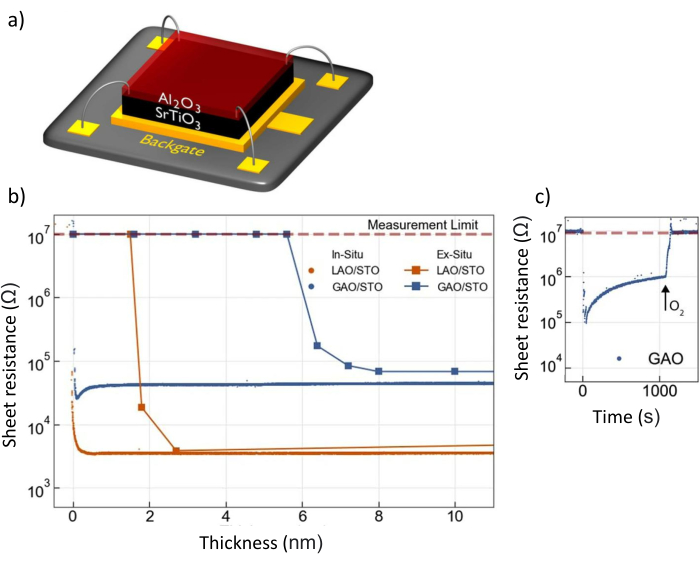A subscription to JoVE is required to view this content. Sign in or start your free trial.
Tuning Oxide Properties by Oxygen Vacancy Control During Growth and Annealing
* These authors contributed equally
In This Article
Summary
Oxide materials show many exotic properties that can be controlled by tuning the oxygen content. Here, we demonstrate the tuning of oxygen content in oxides by varying the pulsed laser deposition parameters and by performing postannealing. As an example, electronic properties of SrTiO3-based heterostructures are tuned by growth modifications and annealing.
Abstract
Electrical, optical, and magnetic properties of oxide materials can often be controlled by varying the oxygen content. Here we outline two approaches for varying the oxygen content and provide concrete examples for tuning the electrical properties of SrTiO3-based heterostructures. In the first approach, the oxygen content is controlled by varying the deposition parameters during a pulsed laser deposition. In the second approach, the oxygen content is tuned by subjecting the samples to annealing in oxygen at elevated temperatures after the film growth. The approaches can be used for a wide range of oxides and nonoxide materials where the properties are sensitive to a change in the oxidation state.
The approaches differ significantly from electrostatic gating, which is often used to change the electronic properties of confined electronic systems such as those observed in SrTiO3-based heterostructures. By controlling the oxygen vacancy concentration, we are able to control the carrier density over many orders of magnitude, even in nonconfined electronic systems. Moreover, properties can be controlled, which are not sensitive to the density of itinerant electrons.
Introduction
The oxygen content plays a vital role in the properties of oxide materials. Oxygen has a high electronegativity and, in the fully ionic limit, attracts two electrons from neighboring cations. These electrons are donated to the lattice when an oxygen vacancy is formed. The electrons can be trapped and form a localized state, or they can become delocalized and capable of conducting a charge current. The localized states are typically located in the band gap between the valence and conduction band with a total angular momentum that can be nonzero1,2,3. The localized states can, ....
Protocol
1. Controlling properties by varying growth conditions
- Preparation of high-quality surfaces of SrTiO3
- Purchase mixed terminated SrTiO3 substrates (e.g., of 5 mm x 5 mm x 0.5 mm in size) with a typical surface angle of 0.05°–0.2° with respect to the (001) crystal planes.
NOTE: The miscut angle determines the flatness of the surface, which is important for epitaxial growth on the substrate, as well as for the resulting properties at the interface. - Clean the desired number of substrates by ultrasonication in acetone for 5 min and ethanol for 5 min at room temperature in a st....
- Purchase mixed terminated SrTiO3 substrates (e.g., of 5 mm x 5 mm x 0.5 mm in size) with a typical surface angle of 0.05°–0.2° with respect to the (001) crystal planes.
Results
Controlling properties by varying growth conditions
Varying the deposition parameters during the deposition of oxides can lead to a large change in the properties, in particular for SrTiO3-based heterostructures, as shown in Figure 2.

Figure 2: Controlling the transpor.......
Discussion
The methods described here rely on using the oxygen content to control oxide properties, and the oxygen partial pressure and operating temperature are, thus, critical parameters. If the total oxidation state of the system is tuned in a way where the system remains in a thermodynamic equilibrium with the surrounding atmosphere (i.e., changed pO2 at high temperature), the changes can be reversible. However, in the case of SrTiO3-based heterostructures, interfacial oxygen vacancies are typically formed.......
Disclosures
The authors have nothing to disclose.
Acknowledgements
The authors thank J. Geyti from the Technical University of Denmark for his technical assistance. F. Trier acknowledges support by research grant VKR023371 (SPINOX) from VILLUM FONDEN. D. V. Christensen acknowledges the support of Novo Nordisk Foundation NERD Programme: New Exploratory Research and Discovery, Superior Grant NNF21OC0068015.
....Materials
| Name | Company | Catalog Number | Comments |
| SrTiO3 | Crystec | Single crystalline (001) oriented, 0.05-0.2 degree miscut angle | |
| LaAlO3 | Shanghai Daheng Optics and Fine Mechanics Co.Ltd. | Single crystalline | |
| Al2O3 | Shanghai Daheng Optics and Fine Mechanics Co.Ltd. | Single crystalline | |
| Chemicals and gases | Standard suppliers | ||
| Silver paste | SPI Supplies, Structure Probe Inc | 05001-AB, High purity silver paint | |
| Ultrasonicator | VWR | USC500D HF45kHz/100W | |
| Wedge wire bonder | Shenzhen Baixiangyuan Science & Technology Co.,Ltd. | HS-853A Aluminum wire bonder | |
| Pulsed laser deposition | Twente Solid State Technologies (TSST) | PLD from TSST with software version V3.0.29, equipped with a 248 nm KrF nanosecond laser (Compex Pro 205 F) from Coherent | |
| Resistance measurement setup | Custom made | Based on the following electrical instruments and custom written software: Keithley 6221 DC and AC current source Keithley 2182A nanovoltmeter Keithley 7001 switch system with a matrix card Keithley 6487 picoammeter | |
| Hall measurements | Cryogenics | Based on the following electrical instruments and custom written software: Keithley 2400 DC current source Keithley 2182A nanovoltmeter Keithley 7001 switch system with a matrix card | |
| Furnace | Custom made | Custom written software control of a FTTF 500/70 tube furnace from Scandia Ovnen AS and a eurotherm 2216e temperature controller |
References
- Pavlenko, N., Kopp, T., Tsymbal, E. Y., Sawatzky, G. A., Mannhart, J. Magnetic and superconducting phases at the LaAlO3/SrTiO3 interface: The role of interfacial Ti 3d electrons. Physical Review B. 85 (2), 020407 (2012).
- Schütz, P., et al.
Reprints and Permissions
Request permission to reuse the text or figures of this JoVE article
Request PermissionThis article has been published
Video Coming Soon
Copyright © 2025 MyJoVE Corporation. All rights reserved